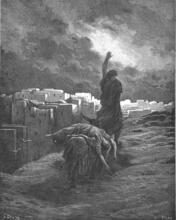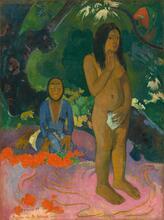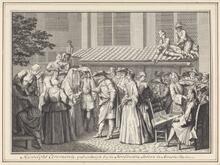Martha, daughter of Boethus
The Laws of marital status for High Priests said that a High Priest could not marry a widow. While Martha’s betrothed, Joshua ben Gamla, was not a High Priest before their marriage, Martha saw to it using her wealth to buy her husband a high position. Being a widow, Martha had to pay an exceptional sum to change the standing marital laws. Perhaps a criticism on over-indulgence, Martha’s end in destitution serves as a critique of wealth in the Temple.
Article
Martha, daughter of Boethus, was a widow from the respected Boethus family of Jerusalem who remarried a future High Priest of Israel. According to tradition, she paid a large sum of money to buy the position for her betrothed, Joshua ben Gamla, from King Yannai (BT Yevamot 61a). In the Lit. (from Aramaic teni) "to hand down orally," "study," "teach." A scholar quoted in the Mishnah or of the Mishnaic era, i.e., during the first two centuries of the Common Era. In the chain of tradition, they were followed by the amora'im.tannaitic (mishnaic) tradition, the marriage of Martha daughter of Boethus and the High Priest Joshua ben Gamla (first century c.e.) is tied to a change in the laws of marital status pertaining to the High Priest. “[A priest who] betrothed a widow, and was subsequently appointed High Priest, may consummate the marriage. It once happened with Joshua b. Gamla that he betrothed Martha the daughter of Boethus, and the King appointed him High Priest, and he consummated the marriage.” (Codification of basic Jewish Oral Law; edited and arranged by R. Judah ha-Nasi c. 200 C.E.MishnahYevamot 6:4; Sifra, Emor 2:6). A High Priest may not marry a widow, but Joshua ben Gamla and Martha are an example of a High Priest married to a widow, although he betrothed her prior to becoming a High Priest. It can be assumed that Martha saw to it that her future husband achieved a high position, and perhaps even used her wealth to bring about the change in the The legal corpus of Jewish laws and observances as prescribed in the Torah and interpreted by rabbinic authorities, beginning with those of the Mishnah and Talmud.halakhah.
Her most outstanding characteristic was her great wealth. She is cited as an example of a wealthy woman in the context of the laws of mezonot (alimony) (BT Ketubbot 104a, JT Ketubbot 5:11, 30b); monetary payments to a widow (Sifrei, Deuteronomy 281). In a similar vein it is said of her sons that “one of them could carry two sides of a huge ox which cost one thousand zuz and walk with them, heel to toe [up the altar ramp to the altar] …” (BT Booth erected for residence during the holiday of Sukkot.sukkah52b).
Martha daughter of Boethus is among the mothers of High Priests—women of wealth and standing from prestigious families of the high priesthood who marry High Priests. Their status is a direct result of their family ties and affluence, which afford them the resources to be active and involved in the politics of the Holy Temple (Safrai 2002), comparable to monied women with high standing throughout the Roman Empire of the time (Halett 1984).
Finally, she is a classic example of the fall of the daughters of Jerusalem from great riches to destitution (BT Writ of (religious) divorceGittin 56a; Eikhah Rabbah 1:86). While the emphasis in these accounts is on stories of great wealth, they also join the corpus of disaster narratives in which women serve to symbolize the enormity of a given catastrophe (Hasan 1996). In this case, they reflect the downfall of the Temple through the respected women of the Temple. The stories of Martha and her dismal end may also represent a criticism of over-indulgence and excessive wealth and perhaps even of religious conduct in the Temple (Cohen 1976).
Cohen, Naomi. “The Theological Stratum of the Martha b. Boethus Tradition.” HTR 69 (1976): 187–195.
Halett, J. Daughters and Fathers. London: 1984. 60–61.
Hasan-Rokem, Galit. Web of Life (Hebrew). Tel Aviv: 1996. English edition: Web of Life: Folklore and Midrash in Rabbinic Literature. Stanford CA: 2000.
Safrai, Chana. “Mothers of High Priests” (Hebrew). In Ishah be-Yerushalayim, edited by T. Cohen and Y. Schwartz, 11–32. Ramat Gan: 2002.







